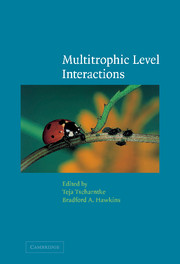Book contents
- Frontmatter
- Contents
- List of contributors
- 1 Multitrophic level interactions: an introduction
- 2 Plant genetic variation in tritrophic interactions
- 3 Multitrophic/multispecies mutualistic interactions: the role of non-mutualists in shaping and mediating mutualisms
- 4 Tritrophic interactions in tropical versus temperate communities
- 5 Endophytic fungi and interactions among host plants, herbivores, and natural enemies
- 6 Multitrophic interactions in space: metacommunity dynamics in fragmented landscapes
- 7 The chemical ecology of plant–caterpillar–parasitoid interactions
- 8 Canopy architecture and multitrophic interactions
- 9 Tritrophic below- and above-ground interactions in succession
- 10 Multitrophic interactions in decomposer food-webs
- Index
8 - Canopy architecture and multitrophic interactions
Published online by Cambridge University Press: 08 August 2009
- Frontmatter
- Contents
- List of contributors
- 1 Multitrophic level interactions: an introduction
- 2 Plant genetic variation in tritrophic interactions
- 3 Multitrophic/multispecies mutualistic interactions: the role of non-mutualists in shaping and mediating mutualisms
- 4 Tritrophic interactions in tropical versus temperate communities
- 5 Endophytic fungi and interactions among host plants, herbivores, and natural enemies
- 6 Multitrophic interactions in space: metacommunity dynamics in fragmented landscapes
- 7 The chemical ecology of plant–caterpillar–parasitoid interactions
- 8 Canopy architecture and multitrophic interactions
- 9 Tritrophic below- and above-ground interactions in succession
- 10 Multitrophic interactions in decomposer food-webs
- Index
Summary
Introduction
Predator–prey, parasitoid–host, and other arthropod interactions do not occur in a vacuum, nor in a featureless world, but in a highly structured and complex environment. This basic observation has triggered numerous theoretical and empirical studies at the population level. Many are centered on the dynamics of populations occupying different patches (summarized in Hassell, 2000). A metapopulation framework implies a spatial arrangement of patches and movement of predators between them. However, once in a patch, a homogeneous spatial situation is again assumed, and predators search at random. In fact, we know of very few examples of arthropod predator–prey or host–parasitoid studies which do incorporate the geometry of the environment at a smaller scale than a patch. In particular, we do not know any study that satisfactorily quantifies the architecture of the plant canopies and its influences on the outcomes of the interactions. This is surprising given that a great majority of predator–prey and parasitoid–host interactions occur in vegetation. Filling this gap is the thrust of this chapter.
The disregard for the architecture of the environment, in particular plant architecture, has two explanations. First, concepts and methods for mapping and modeling plant architecture have been developed only recently, i.e., mainly from the 1980s. Plant architecture, in particular tree architecture, has been the subject of intense research for quite some time (see for example Halle and Oldeman, 1970; Halle et al., 1978), but this work was of a qualitative nature.
- Type
- Chapter
- Information
- Multitrophic Level Interactions , pp. 174 - 196Publisher: Cambridge University PressPrint publication year: 2002
- 23
- Cited by

